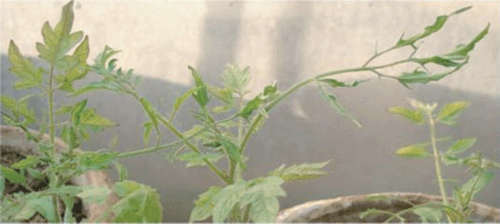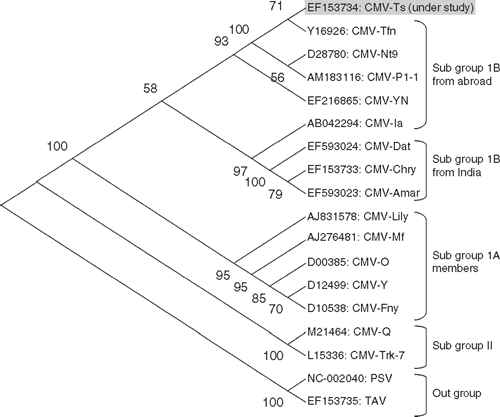First molecular identification of a Cucumber mosaic virus isolate causing shoestring symptoms on tomato in India
D. Pratap A , S. Kumar A and S. K. Raj A BA Molecular Plant Virology, National Botanical Research Institute, Lucknow 226 001, India.
B Corresponding author. Email: skraj2@rediffmail.com
Australasian Plant Disease Notes 3(1) 57-58 https://doi.org/10.1071/DN08023
Submitted: 9 October 2007 Accepted: 15 April 2008 Published: 1 May 2008
Abstract
A virus associated with shoestring symptoms on tomato in India was identified as a subgroup IB isolate of Cucumber mosaic virus based on a complete sequence of RNA 3.
Tomato is one of the important vegetable crops grown commercially in India. Cucumber mosaic virus (CMV) is a major constraint of tomato cultivation. Shoestring symptoms were observed on leaves of several tomato plants growing in a field near the bank of Gomti River in Lucknow, India during winters in 2005–06. This paper reports the biological and molecular identification of the isolated virus.
The virus was successfully transmitted by mechanical inoculations on Chenopodium amaranticolor, Gomphrena globosa, Nicotiana rustica, N. glutinosa and Lycopersicon esculentum. Necrotic local lesions were observed on C. amaranticolor and G. globosa and systemic mosaic on N. rustica and N. glutinosa. Shoestring symptoms on L. esculentum were obtained 25 days after inoculation (Fig. 1). Ouchterlony double diffusion tests with crude antigen from naturally as well as experimentally infected tomato plants also showed a strong reaction with antiserum of CMV (PVAS 242a, ATCC, USA), confirming the presence of CMV.

|
For further identification of the virus isolate at molecular level, total RNA was isolated from naturally infected tomato leaf tissue as described earlier (Spears and Longhurst 1993) and reverse transcription–polymerase chain reaction (RT-PCR) was performed. A pair of primers specifically designed from the sequence data of CMV-Fny (GenBank accession D10538) for the amplification of the complete RNA 3 genome of CMV was used. The sequences of the reverse and forward primers were: 5′-TGGTCTCCTTTTGGAGGCCCCCACGA-3′ (Rc.2216) and 5′-GATCCCCGGGTAATCTTACCACTGTG-3′ (Fr.1). First strand cDNA synthesis was performed using 200 U of RevertAid™ H-minus Moloney Murine Leukemia Virus (MMuLV) reverse transcriptase (MBI Fermentas, USA) and Rc.2216 primer. PCR was carried out in a PTC-200 thermal cycler (MJ Research) using 10 ng cDNA as template, Fr.1 and Rc.2216 primers and 1.5 U of Pfu DNA Polymerase (MBI Fermentas, USA). An amplicon of the expected size (~2.2 kb) was eluted using a QIAquick gel extraction kit (Qiagen, USA) and ligated into the pGEM-T easy vector system-1 (Promega Corporation, USA). Three positive clones were sequenced from both directions and a consensus sequence submitted to GenBank (Accession EF153734). Basic Local Alignment Search Tool (BLAST) analysis of the sequence data revealed the presence of the complete RNA 3 genome of 2220 nt, which consisted of two open reading frames (ORFs): 3a movement protein (852 nt encoding 283 amino acids) and a coat protein (CP, 657 nt encoding 218 amino acids). The ORFs were separated by a 286 nt intergenic region and flanked by 121 nt and 302 nt untranslated regions (UTR) at the 5′ and 3′ ends, respectively.
Based on the complete RNA 3 sequence, the virus isolate shared highest identity (99%) with Tfn (GenBank accession Y16926) and Nt9 (GenBank accession D28780) isolates of CMV reported from Italy and Taiwan, followed by 97–96% identities with P1-1 (GenBank accession AM183116) and YN (GenBank accession EF216865) isolates from Spain and China. The identities were only 92% with isolates of CMV Amar (GenBank accession EF593023), Dat (GenBank accession EF593024), Chry (GenBank accession EF153733) reported from India. All the strains showing 92–99% identities with the virus isolate in this study belong to subgroup 1B of CMV. The phylogenetic analysis of the virus isolate using MEGA Version 2.1 computer program (http://www.megasoftware.net) showed closest relationships with Tfn, Nt9, P1-1 and YN isolates of CMV reported from abroad (Fig. 2) but distant relationships with Indian isolates of CMV. On the basis of highest identities and closest phylogenetic relationships, the virus isolate associated with shoestring on tomato in India has been identified as a distinct isolate of CMV belonging to subgroup1B.

|
Biological and serological identification of CMV causing mosaic and fern leaf on tomato in India has been performed earlier by Kiranmai et al. (1997, 1998). In addition, restriction fragment length polymorphism (RFLP) analysis of the PCR product of the CP region of a subgroup II CMV strain causing severe mosaic on tomato in south India was also reported recently (Sudhakar et al. 2006). To the best of our knowledge this is the first report of the molecular identification of a CMV strain associated with shoestring on tomato in India.
Acknowledgements
The Authors express gratitude to the Director, National Botanical Research Institute, Lucknow for facilities and Council of Scientific and Industrial Research (CSIR), New Delhi for fellowships to D. Pratap and S. Kumar.
Kiranmai G,
Sreenivasulu P, Nayadu MV
(1997) Characterization of Cucumber mosaic cucumovirus isolates naturally infecting three Solanaceous vegetable crops in Andhra Pradesh. Indian Phytopathology 50, 416–425.

Kiranmai G,
Sreenivasulu P, Nayudu MV
(1998) Epidemiology of cucumber mosaic cucumovirus isolates naturally infecting three solanaceous vegetable crops around Tirupati. Indian Phtopathology 51, 315–318.

Spears J, Longhurst T
(1993) RNA extraction and fractionation. Methods in Plant Biochemistry 10, 1–33.

Sudhakar N,
Prasad DN,
Mohan N, Murugesan K
(2006) First Report of Cucumber mosaic virus Subgroup II Infecting Lycopersicon esculentum in India. Plant Disease 90, 1457.
| Crossref | GoogleScholarGoogle Scholar |



